Planar Chromatography Versus Column Chromatography: A Performance Comparison
LCGC North America
It is hypothesized that in particular cases, conventional planar chromatography provides a more effective and robust system than column chromatography with regard to separation efficiency and peak distribution of mixtures composed of low-retarded analytes. Under similar reversed-phase experimental conditions, a regular distribution of thin-layer chromatography (TLC) spots of four natural estrogens (estetrol, estriol, 17?-estradiol, and estrone) corresponds to strong irregular dispersion of peaks in chromatograms generated by high performance liquid chromatography. In both cases, the efficiency of separation was assessed using simple optimization criteria such as selectivity (?min) and resolution (Rs min). The distribution of chromatographic spots was evaluated using the relative resolution product (r). The results revealed that an excellent separation of the components of interest could be achieved easily using simple nonforced and isocratic TLC. Such an interesting property of planar chromatography is mainly driven by the nonlinear relationship between k and Rf retention factors. This article also reports the practical advantages of TLC for the separation of estrogenic steroid mixtures at different temperatures.
It is hypothesized that in particular cases, conventional planar chromatography provides a more effective and robust system than column chromatography with regard to separation efficiency and peak distribution of mixtures composed of low-retarded analytes. Under similar reversed-phase experimental conditions, a regular distribution of thin-layer chromatography (TLC) spots of four natural estrogens (estetrol, estriol, 17b-estradiol, and estrone) corresponds to strong irregular dispersion of peaks in chromatograms generated by high performance liquid chromatography. In both cases, the efficiency of separation was assessed using simple optimization criteria such as selectivity (amin) and resolution (Rs min). The distribution of chromatographic spots was evaluated using the relative resolution product (r). The results revealed that an excellent separation of the components of interest could be achieved easily using simple nonforced and isocratic TLC. Such an interesting property of planar chromatography is mainly driven by the nonlinear relationship between k and Rf retention factors. This article also reports the practical advantages of TLC for the separation of estrogenic steroid mixtures at different temperatures.
In recent years, the role of planar chromatography (or thin-layer chromatography [TLC]) is systematically increasing. This technique is commonly used as the simple but efficient tool for the prepurification, preliminary separation, and quantification of complex chemical, biological, and environmental samples (1-3). The main advantage of TLC over other specific separation methods such as column liquid chromatography (LC), high performance liquid chromatography (HPLC), or capillary electrophoresis (CE) is that the plate is able to separate a number of samples concurrently within a relatively short analytical run. For the battery of different samples that are separated simultaneously, the separation conditions can be controlled with great precision and, therefore, more robust and accurate results can be obtained. Using a TLC method, the components of interest can be located easily by applying a number of sensitive, selective, and inexpensive visualization mixtures. Moreover, there are a number of advanced detectors for quantification and identification of solutes on TLC plates that are available on the market. Some of them are based upon a mass spectrometry (MS) technology including matrix-assisted laser desorption-ionization mass spectrometry (TLC-MALDI MS) or electron ionization MS (TLC-EI MS) (4,5).

Unlike column chromatography, the planar counterpart can work easily as a two-dimensional (2-D) method. For that reason, this technique has a great ability to separate a number of analytes that are components of complex biosamples including blood, urine, tissue, sewage water, or sediments. To maximize the quantitative information that can be extracted from given 2-D planar chromatograms, the pattern recognition procedures driven by multivariate statistic methods have been developed extensively, particularly for proteomics and metabolomics investigations (6).
It is noteworthy that from its nature, isocratic TLC has a great capability to separate mixtures composed of particular solutes (7). This problem is explained clearly in Figure 1. The relationship between retention of analytes separated on a column and plate is described by the simple equation 1:

where k and Rf parameters denote retention factor and retardation factor, respectively. From this equation, it is obvious that the interdependence between the raw retention factor and the retardation factor values is strongly nonlinear. Therefore, one of the consequences of this irregular behavior is the high capability of planar systems to separate complex mixtures composed of relatively weakly retarded solutes (k < 10). For such solutes under similar experimental conditions (the same type of stationary phase and mobile phase composition), a regular distribution of TLC spots corresponds to strong nonregular dispersion of peaks on the chromatogram generated by the column method. This phenomenon can strongly affect the final separation results of complex samples composed of relatively weakly retarded analytes.
To characterize this problem quantitatively, the common optimization parameters, including minimum values of selectivity (αmin), resolution (Rs min) and relative resolution product r for hypothetical chromatograms given on Figure 1 were calculated. The chromatographic profiles were plotted based upon the following noncritical assumptions:

Table I: Selected optimization criteria calculated for column and planar elution profiles presented in Figure 1
- The developing distance on the plate and the column length was 10 cm.
- The elution of solutes in column chromatography was driven by the 1 mL/min flow rate of mobile phase, and the dead volume was 0.5 mL.
- The chromatographic peaks were formed under column efficiency N = 7000 conditions and the average spot sizes along the developing direction in TLC were 3 mm
.
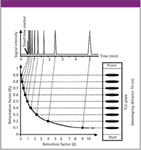
Figure 1: Graphical representation of the relationship between common retention factors in planar (retardation factor Rf) and column (retention factor k) chromatography.
The first two optimization parameters presented in Table I describe the smallest resolution between adjacent peaks (equations 2 and 3). Particularly, α corresponds to the ratio of retention factors and Rs is defined as the difference in the retention times or migration rate of the two peaks divided by the standard deviation of these peaks. For best separation results, the values of αmin and Rs min should be as large as possible within a reasonable total analysis time. From a practical point of view, the resolution is reflecting real separation because the selectivity is calculated from the raw capacity factors.

The r optimization parameter has been introduced by Drouen and colleagues (8,9) and is used widely for a quantitative measurement of the symmetry of chromatographic profiles. The relative resolution product values can be calculated from equation 4:
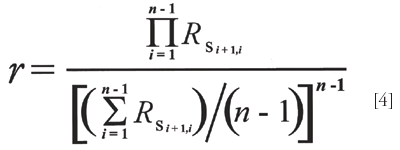
where Rs is the resolution measured between pairs of adjacent peaks, and n denotes the number of solutes. This parameter ranges from 0 for two coinciding peaks to the maximum value of unity when the distances between all peak maxima are equal. In chromatography practice, a simultaneous comparison of these optimization criteria provides a useful tool for the assessment of the separation quality of any complex chromatograms or electropherograms.
As can be seen from the data presented in Table I, for given column and planar chromatograms, the calculated αminvalues are equal. Therefore, both separation systems have the same separation capabilities. However, considering the real separation and symmetry of the peaks distribution (r values), a much better separation on the plate can be expected, particularly for weakly retarded solutes.
One of the important and critical parameters for controlling the selectivity, efficiency, and reproducibility of any separation system is temperature. The relationship between retention and temperature is known as the Van't Hoff plot and is characterized by the equation 5.

where k, ΔH°, ΔS°, and Φ correspond to retention factor, enthalpy change, entropy change, and phase ratio of the separation system, respectively. When the retention mechanism is the same over the temperature range investigated and these parameters are constant, the resulting retention profile yields a straight line (Figure 2). The slope and intercept of the linear plot y = ax+ b correspond to the enthalpy and entropy change.
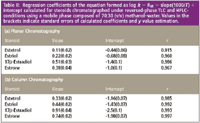
Table II: Regression coefficients of the equation formed as log k = RM = slope(1000/T) + intercept calculated for steroids chromatographed under reversed-phase TLC and HPLCconditions using a mobile phase composed of 70:30 (v/v) methanol-water. Values in the brackets indicate standard errors of calculated coefficients and y value estimation.
The temperature retention profiles can provide valuable information about solute conformation changes, the stationary transitions, and the chromatographic retention mechanism. Unfortunately, under typical LC conditions, the slopes of the retention profiles are low, and therefore, the temperature does not affect the separation particularly, within a narrow range of temperatures. However, the influence of temperature on the selectivity in LC systems can be increased significantly if the mobile phase is modified with inclusion additives. Such systems are an interesting alternative to more complicated gradient methods designed for the separation of complex biosamples (10,11).
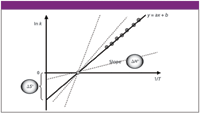
Figure 2: Effect of temperature on chromatographic retention - Vant Hoff plot.
Interestingly, in terms of practical application, the TLC systems are very suitable for separation at different temperatures, particularly at low temperatures. This is mainly because of the low flow rate and small amount of mobile phase is necessary to perform the separation process. Moreover, there is no Joule heat evolved due to electric current flow as in planar or CE systems. Hence, to ensure proper plate temperature, the cooling devices can work with great precision and consume much less energy. For the majority of applications, a constant and reproducible plate temperature can be obtained easily when the developing device is placed directly into the thermostatically controlled ovens or the developing system based upon the Dewar flask that is connected to the external circulating thermostat (12).
Here, we are trying also to support the theoretical concept outlined in Figure 1 by experimental evidence. We also are attempting to demonstrate the advantages of TLC compared with column chromatography with regard to the effect of temperature. It is hoped that this methodological approach can be applied to a metabolomics technology platform, particularly for profiling low molecular mass hormones in complex biosamples.
Experimental
Chemicals:
Estriol, 17β-estradiol, and estrone were obtained from Sigma Chemical Co. (St. Louis, Missouri). Estetrol was a product of Steraloids, Inc. (Newport, Rhode Island). Methanol (99.8% HPLC grade) was obtained from BDH Laboratory Suppliers (Poole, U.K.). HPLC dead volume marker (sodium nitrate) was obtained from a commercial supplier and used as received (POCh, Gliwice, Poland). Water was purified by a Milli-Q system (Millipore Corp., France) In both TLC and HPLC experiments, the mobile phase was 70:30 (v/v) methanol-water. Mobile phases were filtered through a 0.2-μm membrane and degassed on an ultrasonic bath before use. Stock solutions of steroids were prepared in methanol at a concentration of 1 mg/mL. From these stock solutions, appropriate injection standard solutions at a concentration of 20 μg/mL were prepared by mixing the required volume of the stock solution and the chromatographic mobile phase components.
Planar Chromatography
The TLC experiment was performed on RP-18W HPTLC plates from Merck (Darmstadt, Germany). A sample mass of 2 μg of each steroid was applied to the plates, and the developing distance at each temperature was 7 cm. The compounds were located by the use of the visualization mixture (10 g copper(II) sulfate pentahydrate, 5 mL O-phosphoric acid 86% and 95 mL water). Chromatographic data were collected across a temperature range of -20–60 °C in 10 °C intervals using the procedure and equipment described previously (12).
Column Chromatography
Retention and separation studies were carried out on a Supelcosil LC-18 column (10 cm × 4.6 mm, 5 μm) obtained from Supelco, Inc. (Bellefonte, Pennsylvania). The HPLC system consisted of an analytical solvent pump (programmable solvent module 126), UV-vis spectrophotometer (diode-array detector module 168) and System Gold (32 Karat) software and was a product of Beckman Instruments, Inc. (San Ramon, California). Samples were injected using a Beckman model 210A injection valve equipped with a 20-μL loop. The flow rate of the mobile phase was set at 1 mL/min. The column dead volume was determined using sodium nitrate solution at a concentration of 10 μg/mL. The column temperature was equilibrated for at least 30 min at the onset of each new temperature and controlled with an accuracy of ±0.01 °C using an Alltech water jacket (Alltech Associates, Inc., Deerfield, Illinois) connected to a Polystat (Cole Parmer Instrument Co., Chicago, Illinois) digital circulating thermostat.
Results and Discussion
Earlier, we hypothesized that in particular cases, conventional and isocratic planar chromatography can provide a more efficient system with regard to simplicity and separation power than can be expected from its column counterpart. To support this thesis, we compared the separation results of a battery of estrogenic steroids in different temperatures. The separations were done under similar experimental conditions using commercially available reversed-phase column and planar stationary phases. Particularly, the retention of the four natural estrogens including estetrol, estriol 17β-estradiol, and estrone were measured using octadecylsilane-based stationary phases and binary 70:30 (v/v) methanol-water mobile phase. The range of temperatures from -20 to +60 °C was studied according to viscosity and boiling point of methanol-water mixture limitations. The components of interest selection was based upon the importance of such compounds in medicine, the natural environment (for example, endocrine-disrupting compounds), and the well-known fact that under classical reversed-phase column chromatography conditions, the separation of polar estetrol and estriol is much worse than less polar estradiol and estrone (11). Moreover, for effective simultaneous separation of such compounds, long and efficient columns are necessary and the final distribution of the peaks on the chromatograms obtained is strongly irregular. This behavior is typical for a number of binary organic-water or organic-organic mobile phase compositions and for both reversed- and normal-phase systems designed for column separations of estrogenic steroids (11,13). Therefore, for separation and quantification of such compounds, a number of more complicated protocols involving gradient systems or macrocycles modified mobile phases are developed extensively and reported in the scientific literature (11,14-16).
The graphs in Figure 3 show the Van't Hoff plots of estrogens recorded for column and planar chromatography techniques, respectively. In both cases, straight-line results indicate that within the temperatures investigated, the estrogens are retained on the stationary phases by the same retention mechanism. Generally, the lower temperature region provides a better separation of the solutes compared with the separation at higher temperatures. In a comparison of these two sets of lines, the obvious difference is the spread of the data along the y axis. Particularly, the selectivity between the estradiol and estrone is reduced significantly for column separation. The cross-over of the lines represents an incomplete separation of these compounds in the temperature range 30-40 °C. The separation of all compounds investigated always was complete on the plate where the order of elution does not change, regardless of temperature. The coelution temperatures for estradiol and estrone in both systems were estimated using the slopes and intercept values presented in Table II. The accurate temperatures of intersection are 26.3 and 100.8 °C for the HPLC and TLC techniques, respectively. This difference might reflect the differences in chemical structure of the octadecylsilane stationary phases investigated.
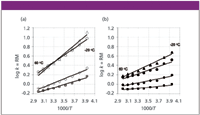
Figure 3: Retention-temperature trajectories of steroids obtained under (a) reversed-phase HPLC and (b) reversed-phase TLC conditions. Components of interest: estetrol (square), estriol (diamond), estrone (circle), and estradiol (triangle).
In practice, the TLC technique provides much better theoretical (α) and real (Rs) separation under the experimental conditions investigated, particularly around room temperature. This is demonstrated by the optimization parameters lines (αmin and Rs min values) plotted in Figures 4a and 4b. The dips that are observed for the column data set are a simple consequence of the 26.3 °C co-elution point for estradiol and estrone peaks. As the figure shows, the TLC separation at room- and low-temperature regions is baseline. On the other hand, satisfactory column separation was observed only for temperatures below 0 °C. It is noteworthy that the planar technique provides chromatograms with good peak distribution regardless of temperature. This is a consequence of both Van't Hoff plot trajectories and the low retention of the components of interest. The calculated minimum and maximum values of capacity factors for estrogens are 0.80 (E4) and 4.76 (E2) at +60 and -20 °C, respectively. Hence, the phenomena of nonlinearity between the raw retention factor and retardation factor values described by equation 1 and visualized in Figure 1 can affect significantly the final result of chromatogram symmetry of estrogens separated by the planar method.

Figure 4: Influence of temperature on the (a) selectivity, (b) separation, and (c) peak distribution of the HPLC (circles) and TLC (black dots) systems investigated.
Conclusions
The high capability of planar chromatographic systems to separate complex mixtures composed of relatively weakly retarded solutes is mainly driven by the nonlinear relationship between
k
and
R
f
retention factors. Our experiment confirms the earlier observations that classical nongradient reversed-phase column chromatography of natural estrogenic steroids including estetrol, estriol, 17β-estradiol, and estrone is strongly characterized by nonsymmetric peak distribution on the chromatograms obtained. We demonstrated that using the same type of stationary and mobile phase composition, this problem can be fixed easily if the column technique is replaced by a simple nonforced isocratic planar method. After that, well-distributed and baseline-separated peaks along the plate are observed under a wide range of temperatures from -20 to +60 °C. This behavior can be explained easily, taking into account the effect of nonlinear independence between the raw retention factor and retardation factor values described by equation 1. Surprisingly, under similar reversed-phase experimental conditions, the separation of estrogens by the column technique was incomplete. The results can be explained by differences in slopes of the Van't Hoff plots observed for individual steroids in the TLC and HPLC systems.
Our observation might be valuable for scientists seeking an inexpensive, simple, and robust separation technique, which is appropriate for prepurification and quantification of a battery of low-retarded compounds in complex mixtures. Particularly, this methodological approach can be applied for the metabolomics technology platforms that involve LC techniques for separation, detection, and quantification of steroids in biosamples.
Acknowledgments
The authors would like to thank the Mothers and Babies Research Center, University of Newcastle, Newcastle, Australia, for financial support, and the University of Newcastle for an RMC New Staff Grant. They also would like to thank the Gladys M. Brawn Memorial Gift Committee for financial support.
References
(1) R. Jain and J. Sherma,
Encyclopedia of Analytical Chemistry
, R.A. Meyers, Ed. (John Wiley & Sons Ltd., Chichester, U.K., 2000), pp. 1583–1603.
(2) L.S. Ettre and H. Kalász, LCGC 19, 712–721 (2001).
(3) C.F. Poole, J. Chromatogr., A 856, 399–427 (1999).
(4) A. Crecelius, M.R. Clench, and D.S. Richards, Current Trends In Mass Spectrometry 19, 28–34 (2004).
(5) H. Brzezinka and N. Bertram, J. Chromatogr. Sci. 40, 609–613 (2002).
(6) E. Marengo, E. Robotti, P.G. Righetti, and F. Antonucci, J. Chromatogr., A 1004, 13–28 (2003).
(7) E. Soczewiński and C.A. Wachtmeister, J. Chromatogr. 7, 311–320 (1962).
(8) A.C.J.H. Drouen, H.A.H. Billiet, P.J. Schoenmakers, and L. de Gallan, Chromatographia 16, 48–52 (1982).
(9) P.R. Haddad, A.C.J.H. Drouen, H.A.H. Billiet, and L. de Gallan, J. Chromatogr. 282, 71–81 (1983).
(10) P.K. Zarzycki and H. Lamparczyk, Chromatographia 48, 377–382 (1998).
(11) P.K. Zarzycki and R. Smith, J. Chromatogr., A. 912, 45–52 (2001).
(12) P.K. Zarzycki, J. Chromatogr., A 971 (2002) 193–197.
(13) H. Lamparczyk, Analysis and Characterisation of Steroids (CRC Press, Boca Raton, Florida, 1992).
(14) P. Kuronen , P. Volin, and T. Laitalainen, J. Chromatogr., B 718, 211–224 (1998).
(15) M.J. López de Alda and D. Barceló J. Chromatogr., A 892, 391-406 (2000).
(16) P.K. Zarzycki, K.M. Kulhanek, and R. Smith, J. Chromatogr., A955, 71–78 (2002).
Pawel K. Zarzycki is with the Laboratory of Toxicology, Department of Environmental Biology, Technical University of Koszalin, Koszalin, Poland, and the Mothers and Babies Research Centre, University of Newcastle, Newcastle, Australia.
Kathrin M. Kulhanek is with Mothers and Babies Research Centre, University of Newcastle, Newcastle, Australia.
Roger Smith is with Mothers and Babies Research Centre, University of Newcastle, Newcastle, Australia.
Malgorzata A. Bartoszuk is with the Department of Pharmaceutical Chemistry, Faculty of Pharmacy, The Medical University of Gdańsk, Gdańsk, Poland.
Henryk Lamparczyk is with the Department of Pharmaceutical Chemistry, Faculty of Pharmacy, The Medical University of Gdańsk, Gdańsk, Poland.
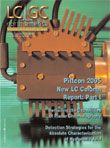
New Method Explored for the Detection of CECs in Crops Irrigated with Contaminated Water
April 30th 2025This new study presents a validated QuEChERS–LC-MS/MS method for detecting eight persistent, mobile, and toxic substances in escarole, tomatoes, and tomato leaves irrigated with contaminated water.
University of Tasmania Researchers Explore Haloacetic Acid Determiniation in Water with capLC–MS
April 29th 2025Haloacetic acid detection has become important when analyzing drinking and swimming pool water. University of Tasmania researchers have begun applying capillary liquid chromatography as a means of detecting these substances.
Prioritizing Non-Target Screening in LC–HRMS Environmental Sample Analysis
April 28th 2025When analyzing samples using liquid chromatography–high-resolution mass spectrometry, there are various ways the processes can be improved. Researchers created new methods for prioritizing these strategies.

.png&w=3840&q=75)

.png&w=3840&q=75)



.png&w=3840&q=75)



.png&w=3840&q=75)













